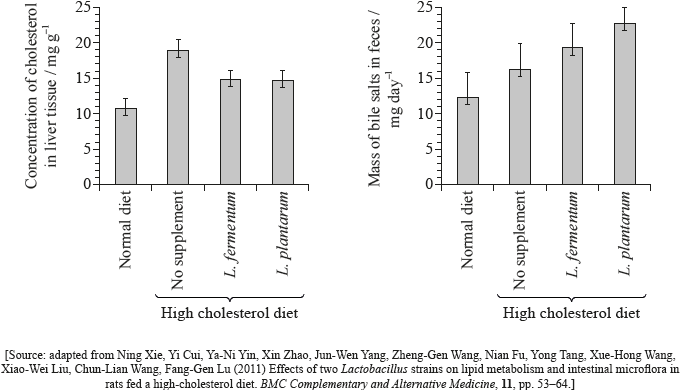| Date | November 2013 | Marks available | 3 | Reference code | 13N.3.HL.TZ0.13 |
| Level | Higher level | Paper | Paper 3 | Time zone | TZ0 |
| Command term | Evaluate | Question number | 13 | Adapted from | N/A |
Question
The cholesterol-lowering effect of Lactobacillus bacteria was studied. Forty rats were divided into groups and fed either a normal or high cholesterol diet. Some rats fed the high cholesterol diet were also supplemented with L. fermentum or L. plantarum. After a six week feeding period, the concentration of cholesterol in liver tissue and the mass of bile salts in feces were measured.

State the concentration of cholesterol in liver tissue and the mass of bile salts in feces for the normal diet, giving the units.
Concentration of cholesterol:
Mass of bile salts:
Calculate the percentage increase in the concentration of cholesterol in liver tissue, caused by feeding the rats a high cholesterol diet without supplementing with bacteria. Show your workings.
Deduce the effects of supplementing the diet with Lactobacillus on the concentration of cholesterol in liver tissue and on the mass of bile salts in feces.
Scientists hypothesized that Lactobacillus could be used in diets to reduce the incidence of coronary heart disease (CHD). Evaluate the evidence for and against this hypothesis provided by the data.
Markscheme
concentration of cholesterol: \({\text{11 mg}}\,{{\text{g}}^{ - 1}}\);
(accept answer in the range of 10.5 mg\(\,\)g–1 to 11.5 mg\(\,\)g–1)
mass of bile salts: 12 mg\(\,\)day–1;
(accept answers in the range of 11.5 mg\(\,\)day–1 to 12.5 mg\(\,\)day–1)
Units are required.
\(19 - 11 = \frac{8}{{11}} = 73(\% )\) (accept answers in the range of 72.7(%) to 81.0(%))
supplementation decreases liver cholesterol in high cholesterol diet;
not enough to bring it to the level of a normal diet;
no difference between L. plantarum and L. fermentum in the decrease of liver cholesterol;
supplementation increases bile salts levels;
greater increase in bile salts levels with L. plantarum / lesser/(perhaps) non-significant increase with L. fermentum;
Evidence for hypothesis:
Lactobacillus/supplements lower liver cholesterol (in high cholesterol diet) which is a risk factor for CHD;
Lactobacillus/supplements increase bile salts in feces which implies some cholesterol may be eliminated;
Evidence against hypothesis:
not known if cholesterol ends up in blood instead thus increasing risk for CHD;
no data about benefit for normal diet/actual decrease of incidence of CHD;
data/results based on rat experiments / may not apply to humans;
WTTE of taking into account difference in bile salt level between L. fermentum and L. plantarum;
Examiners report
Most candidates could provide the values, but fewer could calculate the percentage increase correctly. Most could deduce the effects of the supplement to gain the two marks, but many candidates didn't realize that supplements applied to high cholesterol diets only or failed to mention that cholesterol applied to liver tissue. This had consequences on their evaluation of usage of supplements to treat CHD; many considered only the evidence provided by the cholesterol concentrations supporting the hypothesis.
Most candidates could provide the values, but fewer could calculate the percentage increase correctly. Most could deduce the effects of the supplement to gain the two marks, but many candidates didn't realize that supplements applied to high cholesterol diets only or failed to mention that cholesterol applied to liver tissue. This had consequences on their evaluation of usage of supplements to treat CHD; many considered only the evidence provided by the cholesterol concentrations supporting the hypothesis.
Most candidates could provide the values, but fewer could calculate the percentage increase correctly. Most could deduce the effects of the supplement to gain the two marks, but many candidates didn't realize that supplements applied to high cholesterol diets only or failed to mention that cholesterol applied to liver tissue. This had consequences on their evaluation of usage of supplements to treat CHD; many considered only the evidence provided by the cholesterol concentrations supporting the hypothesis.
Most candidates could provide the values, but fewer could calculate the percentage increase correctly. Most could deduce the effects of the supplement to gain the two marks, but many candidates didn't realize that supplements applied to high cholesterol diets only or failed to mention that cholesterol applied to liver tissue. This had consequences on their evaluation of usage of supplements to treat CHD; many considered only the evidence provided by the cholesterol concentrations supporting the hypothesis.

